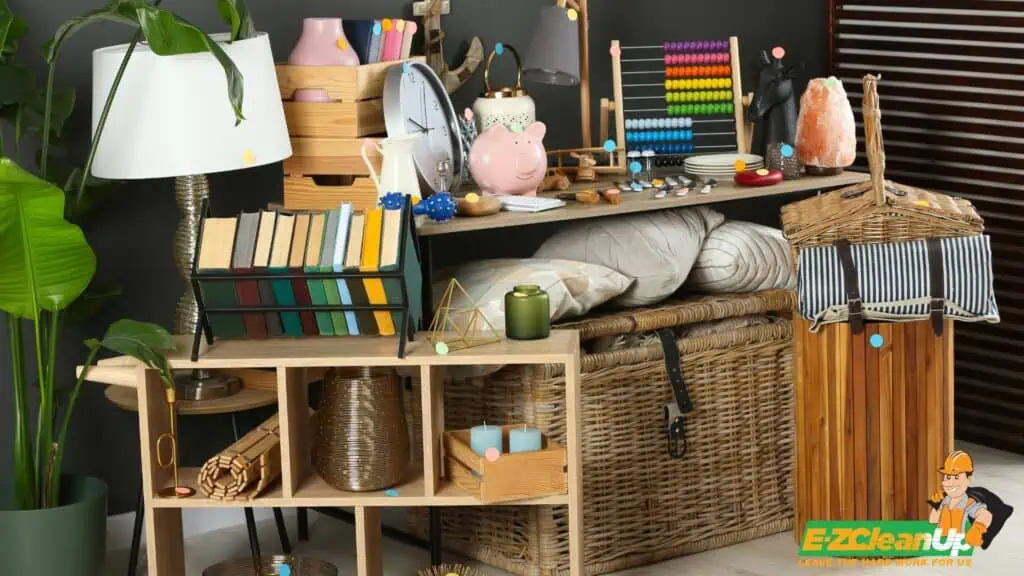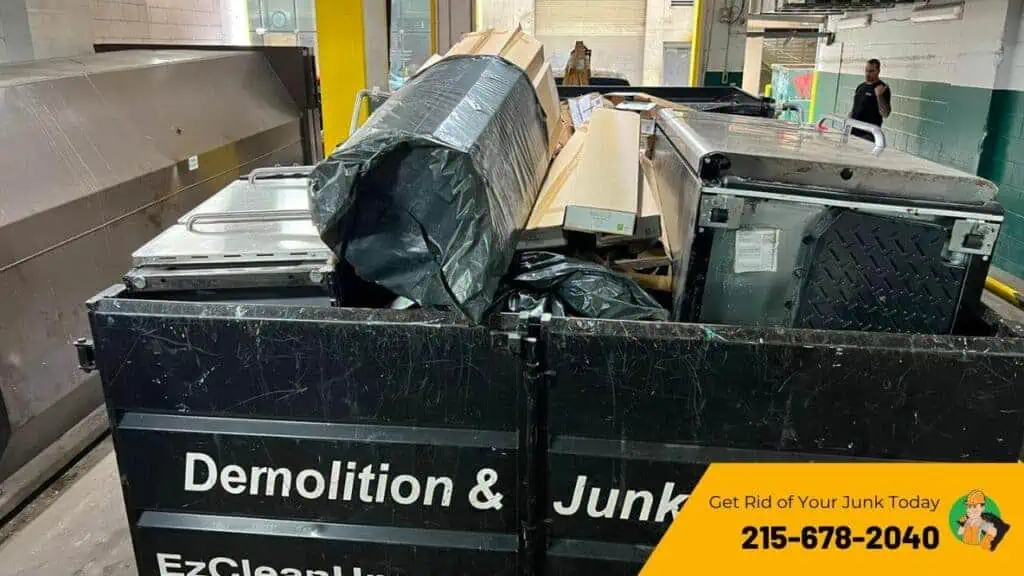To prepare for an estate sale, evaluate and categorize items, address sentimental pieces, organize the sale effectively, set strategic prices, utilize diverse advertising methods, manage the sale efficiently, and consider post-sale options like donations and professional cleanouts.
If you want to learn the step-by-step process on how to prepare for an estate sale, read our guide below.
Step #1: Evaluate the Estate
Start by categorizing your items based on type, such as furniture, collectibles, or jewelry. Utilize online platforms and resources like eBay’s completed auctions to research prices for similar items.
For valuable or rare items, consider consulting with a professional appraiser, who can provide a detailed valuation based on current market conditions.
Deciding What to Sell
Decide which items to sell by taking inventory of everything in the estate. This will help you separate items that are to be sold from those that are to be kept or given away to family members.
Remember, everything from furniture and appliances to smaller items like dishes and linens can be included in the sale if they’re no longer needed.
Handling Sentimental Items
Sentimental items deserve special consideration during an estate sale. If a will does not specify their distribution, discuss with family members to determine if any items should be retained rather than sold.
In some cases, distributing sentimental items among family members before the sale can prevent disputes and ensure that cherished memories are preserved.
Step #2: Organize the Sale
The first thing you must do is to choose a date and time. Settle for weekends, ideally in spring or fall, when more people are available and the weather is conducive to longer stays. Early mornings are typically the best times to start, as this can attract serious buyers looking for the best items.

Arranging Items for Display
Effectively displaying items can significantly influence buyer interest and sales. Arrange items logically by category and room to facilitate easy browsing.
For example, keep kitchen items in the kitchen and group similar items, like books or decorations, together to attract more focused buyers. This enhances the visual appeal and helps buyers envision these items in their own homes.
Setting Up Signs and Directions
Clearly mark different areas and price points to guide visitors smoothly through the space. External signs should lead potential buyers to your sale, while internal signs can help them go to the different sections of the sale. Ensure that the flow of movement is intuitive and allows people to move freely and comfortably.
Step #3: Set Price for Items
When setting prices for an estate sale, the goal is to reflect the true market value of the items to ensure they sell efficiently while maximizing profit. Begin by referencing completed sales of similar items on platforms like eBay or checking historical prices on sites like Antique Roadshow Archives and Everything But The House.
For unique or high-value items, consider consulting with a professional appraiser. They can provide an accurate valuation based on the item’s condition, provenance, and current market trends. This ensures you price these items competitively yet fairly.
Tagging and Labeling
Effective tagging and labeling are critical for managing the flow of an estate sale. Use sturdy, non-adhesive tags for delicate items like antiques and fine art to avoid damage. Each tag should clearly state the price.
For high-value items, include a brief description or note about the item’s significance, which can justify the pricing and engage more informed buyers. Ensure tags are securely fastened to prevent loss or switching, which can lead to disputes or losses during the sale.
Considering Bulk Deals
Implementing bulk deals can be an excellent strategy to move larger quantities of items quickly, particularly those that are lower in value or have less individual appeal. Offer discounts on bulk purchases, such as “buy one, get one half off” for books or kitchen items, or a flat rate for a box of mixed items.
This pricing strategy attracts deal-seekers and encourages buyers to purchase more items. This can potentially increase overall sales. Adjust bulk pricing dynamically as the sale progresses. Consider deeper discounts on the final day to clear remaining stock.

Step #4: Advertise the Sale
Online platforms offer a dynamic space for advertising estate sales. Utilize major estate sale listing sites like EstateSales.org, which can significantly extend your reach to potential buyers.
Additionally, social media platforms such as Facebook, Instagram, and Pinterest are excellent for showcasing items with attractive photos and engaging videos. This visual approach helps to spark interest and draw attendees who are eager to explore the unique finds at your sale.
Community Bulletin Boards and Local Newspapers
Traditional print media and community bulletin boards remain effective for reaching local audiences. Place well-designed flyers in high-traffic areas such as grocery stores, libraries, and community centers.
For a broader reach, consider placing ads in local newspapers, particularly in the classifieds section, which remains a cost-effective option with substantial local reach. This dual approach ensures you capture both digital natives and those who prefer traditional media.
Word of Mouth and Flyers
Word-of-mouth remains one of the most powerful marketing tools. Start by informing friends, family, and neighbors about the sale and encouraging them to spread the word. Additionally, distributing flyers in the local area can effectively generate buzz and attract local attendees.
Step #5: Running the Sale
For efficient management of cash and transactions during an estate sale, it is crucial to implement an efficient system. Using a point-of-sale (POS) system can streamline transactions and help maintain accurate financial records.
Additionally, having multiple people involved in the cash handling process—such as one person collecting cash, another counting it, and a third depositing it—can enhance security and reduce the risk of errors or theft.
Negotiating with Buyers
Effective negotiation strategies are essential for maximizing returns at an estate sale. Always aim for a win-win outcome. Focus on understanding the buyer’s needs and finding agreeable solutions for both parties.
For instance, if a buyer is hesitant, offering a slight discount or including additional items at a lower price might close the deal. It’s also helpful to be prepared for common negotiation tactics buyers might use, such as bundling items for a lower overall price.
Security Measures
Hiring security personnel can be a worthwhile investment, especially if you are selling high-value items. Simple measures like using lock boxes for high-value items and having a well-lit sale area can also deter theft. Additionally, installing temporary surveillance cameras can provide an extra layer of security.
Step #6: After the Sale
After an estate sale, unsold items can be managed through various strategies to ensure nothing goes to waste. Here are a few effective methods:
- Selling in Bulk: Engage local consignment stores, thrift shops, or swap meet resellers interested in purchasing remaining items in bulk, which can help clear out the estate efficiently.
- Buyout Options: Consider a buyout where everything left—including the property—can be sold at a negotiated price, although this may result in lower returns.
Donating to Charity
Donating is a responsible way to handle items that didn’t sell:
- Local Nonprofits: Many estate sales opt to donate unsold items to local charities like the Salvation Army or Goodwill, which can also provide tax benefits.
- Specialized Donations: Depending on the type of items and local availability, donations can also go to shelters or services that support specific community needs.
Final Estate Cleanout and Closure
The final cleanup is crucial for preparing the property for its next phase, whether it’s sale, renovation, or occupancy:
- Professional Cleanout Services: Hiring a professional estate cleanout service like us at EZ CleanUp can ensure that the property is thoroughly cleared without requiring personal effort. These services often include removing large, bulky items and ensuring the home is left in a presentable state.
- Eco-Friendly Disposal: Choose services that emphasize environmentally responsible disposal practices to avoid contributing to landfill waste.

Clear the Way: EZ Estate Clearance
At the end of an estate sale, you may find yourself with more leftovers than anticipated. EZ CleanUp offers a straightforward solution to clear your property quickly and effectively.
Our professional team is ready to sweep through, remove any unsold items, and ensure your estate is impeccably clean. Get in touch with us to learn more about our services or to book a cleanout.













